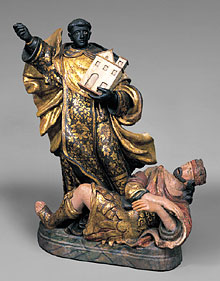
Anonymous, Saint Elesbão, 18th century. Polychromed and gilded wood, 120 x 105 x 50 cm. 5a Superintendência Regional/Instituto do Patrimônio Histórico e Artistico/Ministério de Cultura, Pernambuco. Photo by Fernando Chaves.

Today, the term “Baroque” has connotations of overabundance and an excess of decoration, yet we use it here merely as a convenient label to characterize a long and complex historical period in Brazil that stretches from the seventeenth century to, in some regions such as Minas Gerais, the early decades of the nineteenth century. Most Brazilian Baroque sculpture is made of wood. The sculptures are usually painted in lifelike tones and, to heighten realism, provided with hair and sometimes glass eyes.
Brazilian Baroque sculpture evolved from the hieratic stiffness of seventeenth-century terra-cotta pieces by such artists as Frei Agostinho da Piedade to the Rococo interest in detail and ornamentation of later eighteenth-century works. The sculptures are grouped both thematically and chronologically in the exhibition. There are numerous images of the Virgin Mary, depictions of the life of Christ, as well as male and female saints. One of the most compelling subcategories of saints is that of the so-called “black saints,” such as Saints Efigénia and Elesbão, who were venerated especially in the churches and confraternities established for slaves and former slaves.
Much of this art is intended to be experienced in a public setting, whether in a church or chapel or during the many religious processions that mark the calendar year. Processional sculpture includes scenes of the life as well as the Passion and Death of Christ. Two of the most outstanding artists in the history of Brazilian Baroque sculpture were of African descent: Mestre Valentim (Valentim da Fonseca e Silva), a sculptor, architect, and landscapist active in the region of Rio de Janeiro, and O Aleijadinho (Antônio Francisco Lisboa), a sculptor and architect active in Minas Gerais.
—Edward J. Sullivan